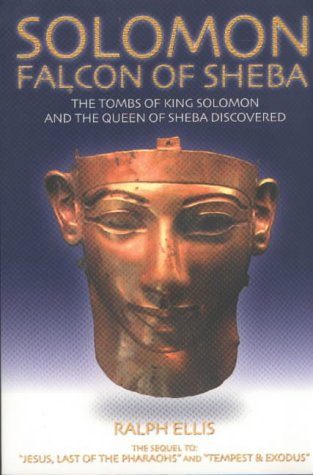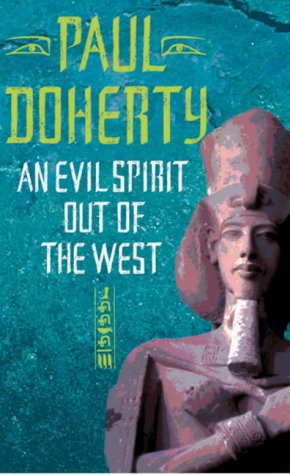|
Ancient Egypt Magazine -- Volume Five Issue Two -- October/November 2004 Review Panel Discovering Egyptian Hieroglyphs: A Practical Guideby Karl-Theodor Zauzich
|
|
In association with amazon.co.uk
Click "GO!" to find Elizabeth Peters books
Alison Millerman
Alison is a long-standing admirer of Amelia Peabody and her entertaining family. She loves Egypt and has made a number of trips there, but has yet to meet Emerson.
Solomon Falcon of Sheba
by Ralph Ellis

Edfu Books 2002. Price £12.00. ISBN 0-9531913-4-6.
The time of David and Solomon in the Tenth Century BC corresponds roughly with the period of the Twenty-first and early Twenty-second Dynasties in Egypt. The Bible text of I Kings 3:1 mentions that Solomon married an Egyptian princess at this time. The name of the Pharaoh is not given but scholars speculate that it may have been the Pharaoh Siamun (c.978-960), penultimate ruler of the Twenty-first Dynasty. However, firm evidence to tie in biblical and Egyptian history appears scarce. Stepping in to fill this void are a number of "alternative" readings of history. It would appear that there is quite a vogue at present among some authors to make the patriarchs of Genesis into the Hyksos Pharaohs. Similarly Moses, depending on which alternative theory you subscribe to, becomes either Tuthmoses the brother of Akhenaten (so Akhenaten is Aaron), perhaps even Akhenaten himself, or, according to one theory, Moses is the Pharaoh Rameses I.
Ralph Ellis has already written two books advocating the Hyksos = Hebrews hypothesis. For the third part of the trilogy he moves down into the first millennium, the time of David and Solomon. His bold conjecture is that David is Psusennes II, the last Pharaoh of the Twenty-first Dynasty; and that Solomon is Shoshenq I, who inaugurated the Twenty-second.
Their tombs are among the famous royal tombs at Tanis discovered in 1939. In addition, the mysterious Queen of Sheba is in reality the God’s wife of Amun, Mutemhat. Her mummy was found among those in the Deir el Bahri cache and now is in the Egyptian Museum, Cairo. Indeed he identifies all the rulers of the Twenty-first dynasty as characters from the Bible, all of them ancestors of David. The book is filled with information, including some fascinating byways about gypsies, Masons, and the Marie Celeste among others. While some readers may enjoy the freewheeling connections, there are, in my opinion, huge problems in accepting the hypothesis.
1. Linguistics: Much of the detailed work seeks to show that the names and titles of the Pharaohs and their court can be matched to biblical names and titles. Thus the name David is taken as a nickname from the Pharaoh Psusennes II whose Egyptian name was Pasebakhen-niut, but reading the star glyph seba as the alternative star glyph djuat. Hence from djuat we arrive at David whose symbol is the famous six pointed Star of David. For those without direct knowledge of both Hebrew and hieroglyphs these "connections" might seem superficially convincing. However, those with more detailed knowledge of these two languages are likely to be much more cautious about the plausability of such direct correspondences.
For one thing Ellis adopts a pretty liberal regime for transliterating, so that the letters aleph and ayin become interchangeable, as do various of the S characters in the two scripts.
2. Hebrew History: In order to accept the thesis, you must be willing to believe in a conspiracy theory of the highest order. The assumption is that later Hebrew scribes did a cover-up job to eliminate all the links with Egypt. However, it is crucial for Ellis’ thesis that sufficient bits of information can be gleaned from much later sources such as the Egyptian historian Manetho, the Jewish writer Josephus, the New Testament, the Ethiopian tradition and the secrets of the Masons. These secondary authors provide the new sources for constructing the "alternative history". So in his reconstruction, characters and places in the Bible are never what they seem. Bathsheba (the mother of Solomon) is also the mysterious Queen of Sheba, who later marries her own son and has a child by him. She enjoys a colourful life as the daughter/wife of David and as the mother/wife of Solomon. Places in Jordan become sites in the Delta of Egypt, and Tyre is not the city in Lebanon but is another name for Tanis. The temple that Solomon builds is not in Jerusalem but is the now ruined complex at Tanis – in other words, Zion is equivalent to the biblical city of Zoan which we know from the Greeks as Tanis.
As you can see almost nothing in the Bible can be taken at face value.
3. Egyptian history: Ellis does not accept the revisionist interpretation of chronology put forward by David Rohl, which is partly based on the Tanis tombs.
By and large Ellis sticks with the conventional dates.
However, in order to bring the biblical names and the Egyptian ones into line he has to re-order some of the kings of the Twenty-first Dynasty. Much more seriously, he has to eliminate altogether the forty-nine year reign of Psusennes I. This is because, while most scholars think the Tomb at Tanis was occupied by Psusennes I (c.1040- 990) Ellis contends it belongs to Psusennes II (c.960-45). In the same way, the brilliant silver hawk-shaped sarcophagus normally ascribed to Sheshonq II (890-889) is said to belong to Sheshonq I (945-924). The two burials thus become those of father and son – in biblical terms David and Solomon.
However we also need to remember that Psusennes was the last king of Manetho’s Twenty-first Dynasty and Sheshonq was the first ruler of the Twenty-second. All standard Egyptian text books see Sheshonq as a Libyan ruler, introducing a new family dynasty. Ellis has therefore to deny that Sheshonq was a Libyan at all. Rather he is a leader of the Shasu who are identified as descendants of the Hyksos. Also I am not sure that the idea of "Solomon-Sheshonq" marrying "Bathsheba/Queen of Sheba = God’s wife of Amun Mutemhat" is plausible. Egyptian kings may have married their sister or daughter, but is there any evidence of a Pharaoh marrying his own mother? It will be clear, therefore, that this history is radically "alternative" and is likely to prove unacceptable to both biblical and Egyptological purists. It is very detailed and certainly provoking.
I suspect that you will either love it or hate it. Whether you decide to put it on the shelf labelled "ancient history" or "fiction" will say a great deal about who you are and where you are coming from.
Michael Tunnicliffe
Michael lectures on Ancient Egypt and Biblical History/Archaeology for the Centres for Continuing Education at the Universities of Liverpool and Manchester, and for the W.E.A.
 click on image to purchase
from amazon.co.uk
click on image to purchase
from amazon.co.uk
An Evil Spirit Out Of the West
by Paul Doherty

A more concise or catchy title, or one which gave some clue as to the content of this novel might have served Doherty better.
It was the familiar image of Akhenaten on the front cover that first caught my eye, and indeed the book is, effectively, a fictionalised account of the Amarnan period in Egyptian history.
Written in the first person, it purports to be the "confession" or autobiography of Mahu, Akhenaten’s Chief of Police, composed some years after the end of the Eighteenth Dynasty. Mahu was a real person, whose unoccupied tomb at Amarna can easily be visited by modern tourists; the "confession" is sadly an invention – if it really existed, it would be a document of immense historical interest.
This leads on to my greatest criticism of the book. Like so many of its type, it mixes fact with fiction in a way that seems deliberately intended to mislead the reader, especially if he or she does not have a background knowledge of Egyptology. It is peppered with quotations and Ancient Egyptian terms, which may or may not be accurate. Only a specialist in the history and literature of the time, of which I am certainly not one, could confirm their validity or otherwise, but as a rank amateur, I noticed a worrying number of glaring errors.
For example, the sixth line of the book, in the list of "Principal Characters", names a certain pharaoh "Hatchesphut": a misprint, I thought, until I read exactly the same spelling later in the text. Perhaps Doherty was referring to someone other than Hatshepsut – this person was seemingly the daughter of Tuthmosis III! Apparently ra mem pet means "the Sun is in the sky" (rather than ra em pet). There are frequent references to fans, which sound much more like the Japanese version than the Egyptian one, and the description of Karnak implies that the Great Hypostyle Hall had been completed, rather than started, during the reign of Amenhotep III. Such mistakes made me question the accuracy of all such quotations and pseudo-historical detail, and rather spoilt the book for me.
Setting aside these niggles, this is still a good read, and one which provides a feasible scenario to explain the rise and fall of Akhenaten and Nefertiti, and perhaps even more interestingly, the subsequent rise to power of Tutankhamun, Ay, Horemheb and Rameses I.
Doherty conjures up a royal Court in which intrigue is rife, and the struggle for ultimate power motivates almost everyone. This I found entirely believable, and a refreshing change from the rose-tinted view sometimes promoted by those who would see Akhenaten in the role of moral religious reformer, rather than half-crazed megalomaniac. At the start of the narrative, most of the principal characters, including Horemheb, Rameses I, Maya and Mahu himself – all familiar names in Egyptology – are made members of the same royal school, called the Kap (Egyptian for nursery or harim, according to Gardiner). This device allows them to remain in close contact throughout the story, and ultimately to influence and direct the course of events to the ultimate benefit of Egypt.
This is one of the most mysterious and fascinating periods of Egyptian history and yet the archaeological evidence is limited.
The reason for the downfall of Akhenaten and Nefertiti, the identity of Smenkhare, the relationship of Akhenaten to Tutankhamun, the life history of Ay, who outlived them all to become pharaoh himself – all are unknown and the source of endless speculation. This story provides as good an explanation of the facts as any.
Peter Phillips
Assistant Editor, AE.
Headline Book Publishing, London; 2003.
available in paperback, priced £6.99.
ISBN 0-7553033-8-5.
 click on image to purchase
from amazon.co.uk
click on image to purchase
from amazon.co.uk
Back to Ancient Egypt Magazine - Volume 5 Issue 2 contents
![]()
|
Return to Home
with questions or comments about Ancient Egypt Magazine. or for sales, subscriptions, back numbers and advertising |